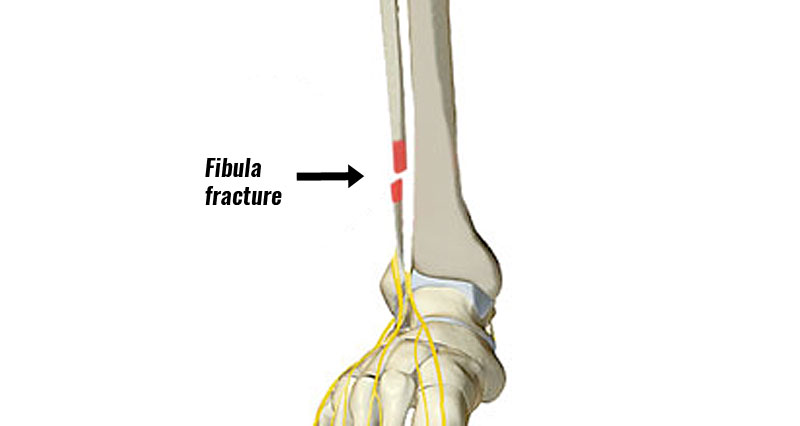
If the broken bone is still in position, you'll usually just need a plaster cast.
#Fibula fracture professional#
How a broken leg is treated Immobilisationįirst, a healthcare professional will give you painkillers and may fix a splint to your leg to secure it in position and prevent further damage.įor severe pain, you may be given painkilling gas through a face mask or medicine through a drip into a vein.Īn X-ray will be done to assess the fracture. If the person is pale, cold and sweaty (in shock), lie them down and keep them warm and calm until you can get medical help.
cover any open wounds with a sterile dressing, a clean cloth or a clean item of clothing – maintain direct pressure on the wound if it is bleeding. do not try to realign any bones that are out of place. avoid moving the injured leg as much as possible – keep it straight and put a cushion or clothing underneath to support it. While you make your way to A&E or wait for an ambulance: If you think you or someone else has broken their leg, go immediately to your nearest accident and emergency (A&E) department.Ĭall 999 for an ambulance if the injury seems severe or you're not able to get to A&E quickly. There may have been a "crack" sound when the leg was broken, and the shock and pain of breaking your leg may cause you to feel faint, dizzy or sick. If it's a severe fracture, the leg may be an odd shape and the bone may even be poking out of the skin. You usually will not be able to walk on it. Once the bone has healed then rehabilitation exercises for the lower leg include stretching, strengthening, proprioception, and sports-specific or functional exercises.A broken leg (leg fracture) will be severely painful and may be swollen or bruised. Treatment for an isolated fibula fractureĪssuming the stability of the ankle is not affected then treatment is rest, pain relief medications as required, and the use of crutches. They are more likely to be caused by repetitive muscle traction forces on the bone. This is because the fibula is not a load-bearing bone. 
However, these are far less common than stress fractures of the tibia.

Stress fractures of the fibula do sometimes occur. A fracture of the bony bit on the outside of the ankle known as the malleolus is called a Pott’s fracture. An avulsion fracture happens when a ligament pulls part of the bone away. Traumatic fractures of the Fibula can occur with a severe ankle sprain. But the ankle is unstable and requires surgery to stabilize the joint. This may appear as a simple injury with mild to moderate pain. Maisonneuve injuryĪ Maisonneuve injury occurs when the membrane connecting the tibia and fibula at the ankle is torn ( high ankle sprain), along with a fracture higher up the fibula. The larger tibia bone bears most of the weight. The function of the fibula is mainly to provide a surface for muscles to attach. This is part of the fibula bone on the outside of the lower leg. The bony lump on the outside of the ankle is called the lateral malleolus. The fibula is the smaller of the two shin bones on the outside of the lower leg. They are usually caused by landing on a twisted foot, or from direct impact or trauma. See fibula stress fracture for more detailed information.
Tenderness over the point of the fracture. A gradual build-up of pain on the outside of the lower leg which eases with rest and increases with activity. Symptoms of a fibula stress fracture include: He fractured his fibula in the first half of the race. He completed the first leg of an Olympic 4x400m heat in a split time of 45 seconds. It is possible to continue to compete with a broken fibula as in the case with American athlete Manteo Mitchell. In more severe cases there will be deformity where bones have been displaced. The athlete will most likely limp or be unable to bear weight on the fractured leg.  Depending on the severity of the injury, the patient may only complain of tenderness over the area of the fracture. However, pain in the calf area is likely to be a lot less than a combined tibia-fibula fracture. Or it can also result from a direct impact on the lower leg. Weight-bearing will be impossible and the lower leg may be deformed.Ī fibula fracture where there is no fracture of the tibia can also occur from landing on a twisted foot. Severe pain usually following an impact, collision, or fall is accompanied by rapid swelling. Fractures of both the tibia and fibula bones in the lower leg will usually be fairly obvious. Combined tibia & fibula fracture symptoms If you suspect a lower leg fracture seek medical attention immediately. Or they can occur on their own in isolation. A fibula fracture can occur at the same time as a tibia fracture.
Depending on the severity of the injury, the patient may only complain of tenderness over the area of the fracture. However, pain in the calf area is likely to be a lot less than a combined tibia-fibula fracture. Or it can also result from a direct impact on the lower leg. Weight-bearing will be impossible and the lower leg may be deformed.Ī fibula fracture where there is no fracture of the tibia can also occur from landing on a twisted foot. Severe pain usually following an impact, collision, or fall is accompanied by rapid swelling. Fractures of both the tibia and fibula bones in the lower leg will usually be fairly obvious. Combined tibia & fibula fracture symptoms If you suspect a lower leg fracture seek medical attention immediately. Or they can occur on their own in isolation. A fibula fracture can occur at the same time as a tibia fracture.







 0 kommentar(er)
0 kommentar(er)
